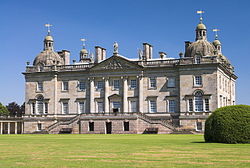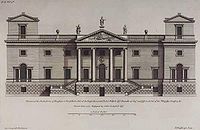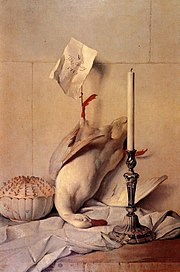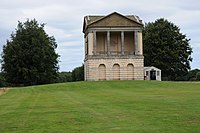Houghton Hall: Difference between revisions
m →top: ioe -> nhle, replaced: {{IoE|221600 → {{NHLE|1152645 |
|||
| Line 17: | Line 17: | ||
'''Houghton Hall''' is a grand country house standing just north of [[Houghton, Norfolk|Houghton]] in [[Norfolk]]. built for the ''de facto'' first British Prime Minister, Sir Robert Walpole, it became the seat of the Marquesses of Cholmondley and is today is the home of David Cholmondeley, 7th Marquess of Cholmondeley.<ref>{{cite news|title=Restoration man: the story of Houghton Hall|url=http://www.telegraph.co.uk/gardening/gardenstovisit/9331651/Restoration-man-the-story-of-Houghton-Hall.html|newspaper=Daily Telegraph}}</ref> | '''Houghton Hall''' is a grand country house standing just north of [[Houghton, Norfolk|Houghton]] in [[Norfolk]]. built for the ''de facto'' first British Prime Minister, Sir Robert Walpole, it became the seat of the Marquesses of Cholmondley and is today is the home of David Cholmondeley, 7th Marquess of Cholmondeley.<ref>{{cite news|title=Restoration man: the story of Houghton Hall|url=http://www.telegraph.co.uk/gardening/gardenstovisit/9331651/Restoration-man-the-story-of-Houghton-Hall.html|newspaper=Daily Telegraph}}</ref> | ||
The house was, and remains is a key building in the history of Palladian architecture in Britain. It is a Grade I listed building<ref>{{ | The house was, and remains is a key building in the history of Palladian architecture in Britain. It is a Grade I listed building<ref>{{NHLE|1152645|Houghton Hall}}</ref> and is surrounded by a thousand acres of parkland, which runs up to the adjoin the parkland of [[Sandringham House]]. | ||
[[File:Houghton Hall.jpg|left|thumb|200px|The planned façade of Houghton Hall from ''Vitruvius Britannicus'']] | [[File:Houghton Hall.jpg|left|thumb|200px|The planned façade of Houghton Hall from ''Vitruvius Britannicus'']] | ||
Revision as of 08:12, 19 September 2019
| Houghton Hall | |
| Norfolk | |
|---|---|
 Houghton Hall | |
| Location | |
| Location: | 52°49’37"N, 0°39’27"E |
| Village: | Houghton |
| History | |
| Built 1722-1735 | |
| Country house | |
| Information | |
| Owned by: | The Marquess of Cholmondeley |
| Website: | www.houghtonhall.com |
Houghton Hall is a grand country house standing just north of Houghton in Norfolk. built for the de facto first British Prime Minister, Sir Robert Walpole, it became the seat of the Marquesses of Cholmondley and is today is the home of David Cholmondeley, 7th Marquess of Cholmondeley.[1]
The house was, and remains is a key building in the history of Palladian architecture in Britain. It is a Grade I listed building[2] and is surrounded by a thousand acres of parkland, which runs up to the adjoin the parkland of Sandringham House.

The house has a rectangular main block which consists of a rustic basement at ground level, with a piano nobile, bedroom floor and attics above. There are also two lower flanking wings joined to the main block by colonnades. To the south of the house there is a detached quadrangular stable block.
The exterior is both grand and restrained, constructed of fine-grained, silver-white stone. The Gibbs-designed domes punctuate each corner. In line with Palladian conventions, the interiors are much more colourful, exuberant and opulent than the exteriors.
The parklands surrounding Houghton was redesigned in the 18th century by Charles Bridgeman.[3] In the process, the village, Houghton, was demolished and rebuilt outside the park.[4] The one exception was the medieval parish church, which was heavily restored and remains within the park.[5]
History

The house was begun in the reign of King George I, whom Sir Robert Walpole served as the King's most trusted minister: his position of power and patronage earned him the informal title 'Prime Minister', which has been used ever since. The new house was built on the site of earlier Walpole family houses. Construction began in 1722 and was completed in 1735.
Walpole was an extravagant host; hunting parties with local Norfolk gentry would last for weeks at a time.[6][7] Visits from Royalty were common and his fellow politicians, particularly members of his Cabinet, held their meetings each spring over a three-week period in the rooms at Houghton. These meetings were known as the Norfolk Congress.[8][9] A grand Palladian pile, Houghton was intended to be the permanent home for more than 400 of his Old Master paintings, including works by Van Dyck, Poussin, Rubens, Rembrandt and Velázquez.[10][11]
Sir Robert Walpole became the 1st Earl of Orford in 1742. Ownership passed to his son and grandson, the second and third earls. On the death of the third earl in 1791, it reverted to his uncle the 4th Earl of Orford, better known as Horace Walpole, the writer. On his death in 1797, possession passed to the family of his sister, Lady Mary, Countess of Cholmondeley, who died at just 26 years in 1731, more than 65 years before.
Sir Robert Walpole's daughter, Mary, had married George Cholmondeley, 3rd Earl of Cholmondeley and Houghton Hall was modified and maintained by her Cholmondeley family across a further span of generations.
In the 1950s, an overdue library book was found in Houghton Hall: it was a book about the Archbishop of Bremen that had been borrowed by Colonel Robert Walpole from the Sidney Sussex College library in Cambridge in 1667 or 1668. The book was returned to the college library, 288 years late.
The house has remained largely untouched, having remained "unimproved" despite the Victorian passion for remodelling and redecorating. Houghton still belongs to the Marquess of Cholmondeley, and parts of the structure and grounds are opened to the public throughout the year.
Art
Houghton once contained part of Sir Robert Walpole's great picture collection, which his grandson the 3rd earl sold in 1779 to Catherine the Great of Russia to pay off some of the estate's accumulated debt. Included in the current collection of paintings is Thomas Gainsborough's oil painting of his own family.[12]

Walpole's collection of marble Roman busts was also noteworthy.[13]
In the early 1990s, Hans Holbein's "Lady With a Squirrel and a Starling" (1528) was removed from the walls of Houghton where it had hung since 1780. It was put up for auction to raise money to pay inheritance taxes and for maintenance of the house and grounds;[14] and eventually, negotiations led to the painting's sale to the National Gallery for £17-million tax free because of special incentives in England for selling works of art that are considered national treasures.[15]
In the 21st century, art market inflation has placed enormous temptations in the way of the old families with substantial collections. In recent years, ownership of several pieces have been transferred in lieu of tax from the Cholmondeleys to the Victoria and Albert Museum. A major sale of items of pictures, furniture, silver and objets d'art from Houghton estimated at $23 million was held at Christie's in London on 8 December 1994, with the intention of establishing an endowment fund for the future preservation of the building.[16] Some artwork, such as William Hogarth's portrait of the Cholmondeley family is unlikely to be let go, and it remains on view at Houghton; but the marquess admits that he is very aware that risk of theft is neither negligible nor negotiable.[17] Jean-Baptiste Oudry's White Duck, stolen from the Cholmondeley collection in 1990, is still missing.[18]
Parkland and gardens
Charles Bridgeman's landscaping plan for the parkland at Houghton remains intact. His "twisting wilderness paths" were cleared in the early 18th century; and they have been maintained since then.[19]
Bridgeman replaced the formal geometry of intersecting avenues with blocks of woodland and parkland which, as he saw it, was better able to complement the Hall's compelling architectural statement.[20]
The ha-ha barriers at Houghton were an innovative feature credited to Bridgeman. In his 1780 "Essay upon Modern Gardening," Horace Walpole explained: "The contiguous ground of the park without the sunk fence was to be harmonized with the lawn within; and the garden in its turn was to be set free from its prim regularity, that it might assort with the wilder country without."[21]

Sir Robert Walpole constructed a watertower (1731–1732) with the appearance of an architectural folly which was designed by Henry Herbert, 9th Earl of Pembroke. It was restored in 1982 and is a Grade I listed building.[22]
In this well-established context, a number of contemporary outdoor sculptures have been commissioned in recent years by David Cholmondeley, 7th Marquess of Cholmondeley. To the west of the house is a circle of Cornish slate at the end of a path mown through the grass. This land art feature was designed by the British sculptor Richard Long.
Two modern follies lie in a wooded area to the side of the west front.
American artist James Turrell contrived "Skyspace" for Houghton. Turrell's construction presents itself from the exterior as an oak-clad building raised on stilts. From the inside of the structure, the viewer's point of view is focused upwards and inevitably lured into contemplating the sky as framed by the open roof.[3]
"The Sybil Hedge" is another folly in this vicinity.[23] It is based on the signature of the current marquis' grandmother, Sybil Sassoon. Scottish artist Anya Gallaccio has created a sarcophagus-like marble structure which is sited at the end of a path; and nearby is a copper-beech hedge which is planted in lines mirroring Sybil’s signature.[3]
A five acre walled kitchen garden lies beyond the stables. Over the course of time, the productive area was reduced in size, and the enclosure was mostly grassed over. In 1996, the fallow enclosure was redesigned and replanted. The effort was rewarded in 2007 when it was named Historic Houses Association and Christie’s Garden of the Year. Yew hedges divide the space into a formal grid of discrete areas or "rooms", each intending to provoke a different interest and mood. The hedges, some cut in swags, give height and form. The garden rooms include an Italian enclosure with box parterres; a formal rose garden laid out in a pattern based on one of the William Kent ceilings in the house; a French garden of pleached limes and plum trees which have been underplanted with spring bulbs; and a croquet lawn.[3]
Danish artist Jeppe Hein created a "Water Flame" sculpture/fountain for this garden. In all seasons, this jet of water surmounted by a ball of flame illustrates a 21st century folly on a smaller scale than the contemporary pieces outside the garden walls.[3]
In 2015, James Turrell created an artistic illumination of Houghton House as part of the LightScape festival celebrating the house and gardens.[24]
Model soldiers
The stable block at Houghton Hall houses the Cholmondeley Collection of Model Soldiers, previously at Cholmondeley Castle and moved to Houghton Hall in 1980 soon after it was opened to the public. The collection was started in 1928 by the 6th Marquess, expanded throughout his life, and now includes about 20,000 figures.[25]
Outside links
| ("Wikimedia Commons" has material about Houghton Hall) |
- Houghton Hall
- Houghton Hall entry from The DiCamillo Companion to British & Irish Country Houses
- Houghton International Horse Trials, held annually in May
References
- ↑ "Restoration man: the story of Houghton Hall". Daily Telegraph. http://www.telegraph.co.uk/gardening/gardenstovisit/9331651/Restoration-man-the-story-of-Houghton-Hall.html.
- ↑ National Heritage List 1152645: Houghton Hall
- ↑ 3.0 3.1 3.2 3.3 3.4 Donald, Caroline. "The new garden at Houghton Hall, King’s Lynn, Norfolk," The Times, 11 May 2008.
- ↑ Lewis, Samuel (1991). A Popular Guide to Norfolk Place Names. The Lark's Press. p. 25. ISBN 0-948400-15-3. https://books.google.co.uk/books?id=y7959lrL2VgC&pg=PA25&lpg=PA25&dq=place+names+of+norfolk+houghton&source=bl&ots=ZuJtBWjWRN&sig=JJwdcAW0i6Vk4sfyg4dKh54wugI&hl=en&sa=X&ei=2gPmUL35Lo-U0QXjrIHgBQ&ved=0CDcQ6AEwATgK#v=onepage&q=place%20names%20of%20norfolk%20houghton&f=false. Retrieved 2014-01-05.
- ↑ Church of St Martin, Houghton - British Listed Buildings
- ↑ Hill, Jonathan (2015). "A Landscape of Architecture, History and Fiction". Routledge. p. 24. https://books.google.com.au/books?id=rWVACwAAQBAJ&pg=PA24. Retrieved 30 December 2015.
- ↑ Songhurst, W. J. (1924). "Ars Quatuor Coronatorum (Volume 8, Transactions from the Norfolk Archeaological Society)". Ars Quatuor Coronatorum. p. 117. https://books.google.com.au/books?id=XrYKAwAAQBAJ&pg=PA117. Retrieved 7 April 2014. "Mrs Herbert Jones is quoted in "Volume 8, Transactions from the Norfolk Archeaological Society" that guests at Sir Robert Walpole's house parties were "royal" and that a letter from a Norfolk gentleman said that a calvacade of visitors and gentry going out hunting "could only be compared to an army going on its march.....""
- ↑ Loschke, Sandra K.. "Materials and Architecture". Routledge. p. 130. https://books.google.com.au/books?id=QaLDCwAAQBAJ&pg=PA130. Retrieved 15 April 2014. "....he (Sir Robert Walpole) entertained friends and allies at a month-long "Norfolk Congress"..."
- ↑ Coxe, William. "Memoirs of the Life and Administration of Sir Robert Walpole". James Easton, Salisbury. p. 758. https://books.google.com.au/books?id=0WQ9AQAAMAAJ&pg=PA758. Retrieved 7 April 2015. "(Walpole) usually had two annual meetings at Houghton, one in the spring, to which were invited his most select friends and leading members of the Cabinet, and continued for about three weeks...the second was in autumn for the (hunting season)... lasting (nearly) two months...to which all gentleman in the county found a ready admission..."
- ↑ Brooker, Nathan. "Houses built for art collections (House and Home - 16 March 2013 )". The Financial Times. http://www.ft.com/cms/s/2/2638a24c-8715-11e2-9dd7-00144feabdc0.html. ""Walpole lived rather high on the hog, you could say, and would spend vast sums of money on art and entertaining his political cronies, and then borrow more," says Cholmondeley."
- ↑ White, William (1836). "History, gazetteer, and directory, of Norfolk, and ... the city of Norwich". W. White. p. 648. https://books.google.com.au/books?id=7xYHAAAAQAAJ&pg=PA648. Retrieved 7 April 2015. "(Houghton Hall) was visited yearly by all the great officers of state...this annual meeting...was called the (Norwich) Congress...."
- ↑ Thomas Gainsborough, with His Wife and Elder Daughter, Mary (circa 1751-1752)
- ↑ Michaelis, Adolph. (1882). Ancient Marbles in Great Britain, p. 324.
- ↑ Vogel, Carol. "The Art Market," New York Times. February 21, 1992.
- ↑ Vogel, Carol. "Inside Art," New York Times. March 4, 1994.
- ↑ 'Houghton Revisited': John Richardson in Vanity Fair, 1994
- ↑ Bryant, Chris. "Heritage for sale," Times (London). July 17, 2007.
- ↑ Lyall, Sarah. "A Titian Is No Longer at Large; Its Thief Is," New York Times. September 19, 2002.
- ↑ Conan, Michael: 'Baroque Garden Cultures: Emulation, Sublimation, Subversion' page 399 (2005)
- ↑ Whyte, Ian D.: 'Landscape and History since 1500' page 81 (2002)
- ↑ Walpole, Horace (1780)
- ↑ National Heritage List 1342318: The Watertower
- ↑ McCarthy, Anna. "Focus on Jeffe Hein," Houghton Hall Education Newsletter, January 2009, p. 3.]
- ↑ Gayford, Martin. "James Turrell interview: ‘I sell blue sky and coloured air’". Spectator. http://www.spectator.co.uk/arts/arts-feature/9553392/james-turrell-interview-i-sell-blue-sky-and-coloured-air/.
- ↑ The Cholmondeley Collection of Model Soldiers, leaflet, Houghton Hall
- Conan, Michael. (2005). Baroque Garden Cultures: Emulation, Sublimation, Subversion. Washington, D.C.: Dumbarton Oaks Research Library and Collection. ISBN 9780884023043; OCLC 185320499
- Adolf Michaelis, Adolf. (1882). Ancient marbles in Great Britain. Cambridge: Cambridge University Press. OCLC 68091266
- Moore, Andrew W. (1996). Houghton Hall: The Prime Minister, The Empress and The Heritage. London: Philip Wilson Publishers. ISBN 978-0-85667-438-9; OCLC 36167076
- Whyte, Ian D.: 'Landscape and History Since 1500' (Reaktion Books, 2002) ISBN 978-1-861-89138-9; OCLC 248507175
